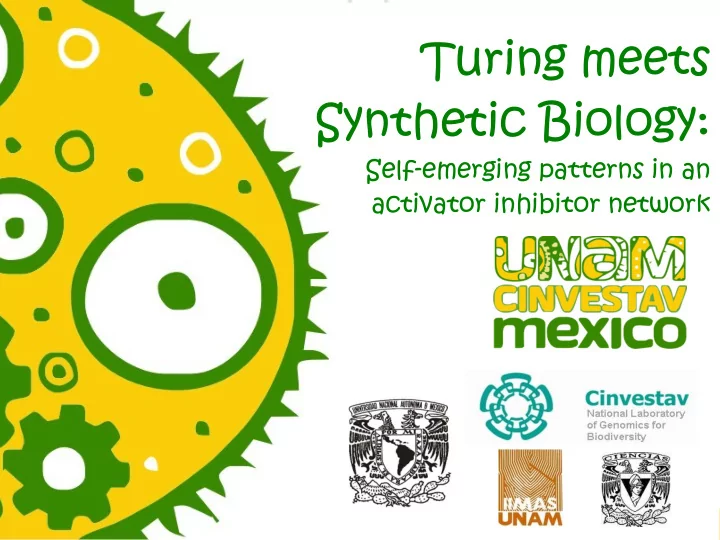

Turing meets Synthetic Biology: Self-emerging patterns in an activator inhibitor network
Turing meets Synthetic Biology: The main goal of the project was to show that Turing patterns could be obtained by the action of an underlying genetic regulatory network
Morphogenesis and Turing Patterns ✔ Size and shape in nature ✔ Developmental biology ✔ Unknown general mechanisms and the role of underlying genetic regulatory networks
Turing approach ✔ Positional information (chemicals) ✔ The chemical basis of morphogenesis ✔ Chemicals that interact and diffuse through the medium ✔ Reaction-Diffusion systems ✔ Genes by themselves do not produce the pattern
Activator-Inhibitor ✔ Gierer and Meinhardt, 1972 ✔ Local Activation and long range inhibition ✔ Fire and grasshoppers analogy
Conditions for pattern generation ✔ The existence of at least two morphogenes with different nature that chemically interact between them and diffuse over space.
Conditions for pattern generation The existence of at least two morphogenes with different nature that chemically interact between them and diffuse over space. ✔ The coefficient rates of diffusion should be different.
Conditions for pattern generation The existence of at least two morphogenes with different nature that chemically interact between them and diffuse over space. ✔ The coefficient rates of diffusion should be different. ✔ The starting distribution of morphogenes should not be completely homogeneous over space.
Conditions for pattern generation The existence of at least two morphogenes with different nature that chemically interact between them and diffuse over space. ✔ The coefficient rates of diffusion should be different. ✔ The starting distribution of morphogenes should not be completely homogeneous over space. ✔ Local activation and long range inhibition.
AHL Diffusion ✔ Lux ✔ Las
Inverters ✔ Lac Inverter ✔ Tet Inverter
Substrates ✔ IPTG ✔ ATC
Autocatalisis
Activation
Inhibition
Diffusion
Substrates
Complete system
Our system can generate a pattern... ...Because : ✔ It recognizes at least two morphogenes: Las AHL and Lux AHL;
Our system can generate a pattern... ...Because : ✔ It recognizes at least two morphogenes: Las AHL and Lux AHL; ✔ The chemicals diffuse with different rates;
Our system can generate a pattern... ...Because: ✔ It recognizes at least two morphogenes: Las AHL and Lux AHL; ✔ The chemicals diffuse with different rates; ✔ We can give an non-homogeneous start condition according to gradients of IPTG and ATC;
Our system can generate a pattern... ...Because: ✔ It recognizes at least two morphogenes: Las AHL and Lux AHL; ✔ The chemicals diffuse with different rates; ✔ We can give an non-homogeneous start condition according to gradients of IPTG and ATC; ✔ And the local activation and long range inhibition will happen in the media by Lux and Las Quorum sensing systems.
Single cell mo model: kinetic rules mluxI = k trans ∗ luxI − k mdeg ∗ mluxI LuxI = k trad ∗ mluxI − k pdeg ∗ LuxI AI = k cat ∗ luxI − k deg ∗ AI
Single cell mo model: kinetic rules GFP = k trans ∗ gfp ∗ F 1 − k mdeg ∗ mgfp F 1 = 2 [ LasR PAI ] 2 k d 1 2 2 1 [ LasR PAI ] 1 [ LasR PAI ] 2 2 k d k d
Single Cell model: Activator module
Single Cell model: Inhibitor module
Single Cell model: Interaction
Single Cell model: Substrates modules
Single cell model
Single Cell model: Full system
Classical l model l with estimated diffusion constants Based on Einstein's equations and bibliographical search we estimated the following constants: with the Gierer and Meinhardt kinetics and an inhomogeneous initial condition we obtained this patterns.
Spatial model from the single cell aproach When simulated con ✔ Comsol Multiphysics software with the reaction diffusion equations we obtained these results. The initial condition was ✔ non-homogeneous.
Experimental Implementation ✔ E. coli cells with the biobrick system ✔ Four modules:
Experimental Implementation ✔ E. coli cells with the biobrick system ✔ Two plasmids with different resistance
Biobricks in the registry ✔ 11 new biobricks, standard assembly 10 ✔ Inverters, protein generators, and AHL senders
Activator Test ✔ LasR inverter controlled by pLac and IPTG ✔ GFP and LasI controlled by PAI + LasR
Activator Test ✔ LasR inverter controlled by pLac and IPTG ✔ GFP and LasI controlled by PAI + LasR
Testing the system ✔ Activator module with basal GFP and Activator cells with IPTG NO IPTG IPTG
Progress ✔ Biobrick system 90% ready ✔ 1 ligation to finish ✔ Relation between IPTG and GFP expression ✔ Functional activator module
Difficulties ✔ 1 month delay in the Biobricks distribution ✔ Lack of Spe1 ✔ Reactives delivery time
Collaboration ✔ LCG-UNAM-MEXICO & IPN-UNAM-MEXICO
Conclusions ✔ We built a synthetic biobrick network of activator- inhibitor type that gives the cells the potential to differentiate according to morphogenes and substrates gradients by expressing GFP ✔ Qualitative requeriments to produce a pattern ✔ Activator module working ✔ Modeling plays a crucial role
Conclusions ✔ We will be able to reproduce non-trivial behavior given by simple physical mechanisms ✔ We used synthetic biology to test the biological viability of theoretical models
Future work & Perspectives ✔ Coupling Inhibitor module ✔ Implementation of gradients of IPTG and ATC ✔ Effective morphogenes ✔ Eucariotic tissues ✔ Mice melanocites ✔ :D
New initiatives ✔ Collect local bacteria with interesting features that can be used in synbio applications ✔ Identify and isolate specialized functions ✔ Biosensors
THANK YOU!
Recommend
More recommend